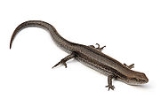The
Pale-flecked Garden Sunskink or
Common Garden Skink (
Lampropholis guichenoti) is a small common
skinkSkinks are lizards belonging to the family Scincidae. Together with several other lizard families, including Lacertidae , they comprise the superfamily or infraorder Scincomorpha...
often seen in suburban gardens in
MelbourneMelbourne is the capital and most populous city in the state of Victoria, and the second most populous city in Australia. The Melbourne City Centre is the hub of the greater metropolitan area and the Census statistical division—of which "Melbourne" is the common name. As of June 2009, the greater...
and
SydneySydney is the most populous city in Australia and the state capital of New South Wales. Sydney is located on Australia's south-east coast of the Tasman Sea. As of June 2010, the greater metropolitan area had an approximate population of 4.6 million people...
in
AustraliaAustralia , officially the Commonwealth of Australia, is a country in the Southern Hemisphere comprising the mainland of the Australian continent, the island of Tasmania, and numerous smaller islands in the Indian and Pacific Oceans. It is the world's sixth-largest country by total area...
, but is common across most of
Southern AustraliaThe term southern Australia is generally considered to include the States and territories of Australia of New South Wales, Victoria, South Australia, Tasmania and the Australian Capital Territory...
and some of New South Wales.
Description
It grows to a maximum of 14 cm, but rarely exceeds a size of 9 cm. According to statistics, the average Common Garden Skink lives up to 2-3 years. The Garden Skink usually has a browny black colour and sometimes may appear a dark shade of red when bathing in the sun.
Diet
Garden skinks feed on small invertebrates including crickets, moths, slaters, earthworms, flies, grubs and caterpillars, grasshoppers, cockroaches, earwigs, slugs, small spiders, ladybeetles, ants and many other small insects, which makes them a very helpful animal around the garden. They can also feed on fruit and vegetables, but the vegetables have to be cooked for the skink to be able to eat it. Skinks especially love bananas and strawberries etc. (citrus fruit). Garden skinks rely purely on the movement of their prey when hunting. If their prey is not moving, they will not see it as edible and will not strike. When hunting, the skinks will either hide and wait for prey to come by or actively pursue it (this depends on how hungry they are). Once they have caught their prey, they shake it around vigorously to kill it before swallowing it whole. Once they have had one meal, they begin to actively pursue prey for a short while with their new found energy. Skinks only need one prey item per 4 or 5 days, but will eat every day if conditions are good, thus, making it an ideal pet for small children.
Habitat
They are often seen under leaves, in long grass and under rocks so that they can watch their prey, they also love hiding in logs where their big predators can't get them. As all reptiles are cold blooded, you may see them on top of rocks or paths in the morning trying to warm their blood. Skinks enjoy large areas with a lot of leaves and soft dirt. You normally find them around hot and dusty areas that have lots of trees and stumps.
Predators
The Garden Skink's predators are mainly birds, even tiny birds like robins, are a threat to skinks. Sometimes larger lizards and snakes will try to eat them as well. Just like most other skinks, it's tail will drop if grasped roughly. The diconnected tail then twitches vigorously for a while, to hold the attention of the predator while the lizard makes its escape. Though, this survival tactic may seem easy for the skink to tolerate, it is quite the opposite. Although it may cost the skink some energy, the skink's tail will eventually grow back.
Eggs
The Common Garden Skink is oviparous and lays small, white eggs between summer and mid-autumn. The female usually lays about six eggs, often in communal clutches that may contain as many as 250 eggs altogether, usually under a cluster of rocks to keep them safe from predators. The eggs hatch in a matter of weeks after they are laid.
The source of this article is
wikipedia, the free encyclopedia. The text of this article is licensed under the
GFDL.


